Never Fear Knits Pt 6
Thanks for following along with the series so far! Today we’re talking support systems – stabilizers, elastic, interfacing, etc. To recap, you can read all the Never Fear Knits posts here.
Interfacing
Occasionally you’ll come across a knit pattern that requires interfacing – think wide waistbands on jersey dresses. Yes, they do make knit interfacing and yes, it does stretch.
You’ll find it in the store mixed in with the rest of the interfacings. The knit kind resembles tulle, I think. Tiny threads weaved with space between. The side that’s a little shiny is the side with the adhesive. Knit interfacing gives support but still allows for a minor amount of stretch.
Stay Tape
Even though knits stretch there are certain parts of knit garments that you don’t want to stretch out – like shoulder seams. You can stitch some clear elastic the length of the shoulder into the seam or you can use one of my favorite notions – stay tape. It looks like a small weaved net that comes on a roll and will stabilize your seam. Just feed it into your machine, on top of the fabric, as you sew leaving about an inch extending at either end that you trim when finished.
Elastic
For waists of dresses you’ll probably need some elastic to maintain the shape. Clear elastic is often used with knits but you can also use regular.
If you want the waistband to lay flat you’ll cut your elastic the length of the waist measurement of the dress. That way, the dress will stretch as you put it on but when you wear it the elastic will keep that waist nice and fitted.
Like with Stay Tape you lay the elastic on top of the fabric as you feed it under the presser foot. This time I’ve sewn it on the serger.
As you can see from the above pictures – the elastic (right) stretches while the stay tape (left) is firm.
Sewing Stabilizers
Sulky makes a tear away stabilizer that you stitch right on to your fabric. I’ve never had to use it but it could be helpful to beginners. So if you’re having trouble sewing an especially tricky knit, this might help!
***Phew, almost done! Tomorrow we’ll go over a list of possible trouble spots when sewing knits and what to do to avoid them. I’ll even add a couple places I like to buy knits as well as some extra resources for knit sewing.
After that I’ll release the new pattern and gear up for the sew-a-long where we can put all of this usefulness into action!
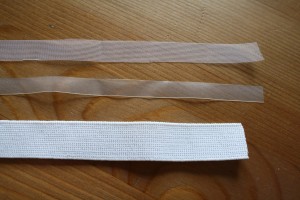
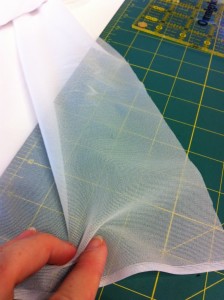
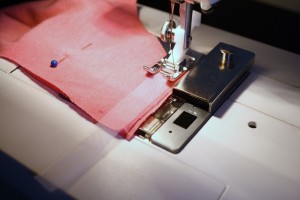
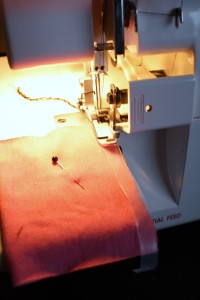

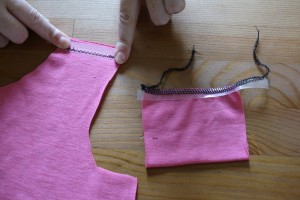
Hi Dixie,
I’ve been following your knit series closely–thanks for putting this together for all of us!
One of the first projects I sewed for myself was an interlock knit t-shirt. The pattern told me to use fusible knit interfacing to stabilize the neckline facings. (Yeah, facings in a knit t-shirt–very strange.)
I had a very difficult time fusing the interfacing to the fabric. Can you give me any tips on how to do this? And I also heard from different sources that it isn’t good practice to use an iron on knits. . . But then some patterns call for fusible interfacing. What do you think?
Did I really need to use fusible before? What substitute could I have used?
The thing about ironing knits is you don’t want to stretch them out. You want the fabrics to stay in their natural state as much as possible. When you iron, don’t drag the iron around on the fabric, just place it down for a few seconds, lift and move to a new section.
I, and many others, hate facings for most any kind of knit, especially t-shirts. Seems so unnecessary, right?
Are you using a knit interfacing? What kind of problems specifically are you having? Will the interfacing not adhere at all or does it have bubbles or…?
I’m assuming the pattern wants a facing so that you won’t have a stitch line at the neck, but if you wanted, as an alternative you could create a thin neck band by cutting a long strip of fabric (the length going on the crossgrain or whichever way has the most stretch). The band’s length should be slightly smaller than the size of the neck opening. You then adhere it like bias tape binding but stretching the band strip evenly to fit the neck opening (pinning it down first helps to make it even). The reason you want a slightly smaller band length is because it helps to pull the neck together to maintain it’s shape.
Hi Dixie,
Yes, I used a knit interfacing and I had trouble adhering it to the fabric. Any tips on how to do this properly?
Yeah, your idea of using a knit band for the neckline sounds 100% better than the facings. I haven’t done a knit band before so your mention of making a band slightly smaller than the neckline is something I should write down. Thanks!
Rebekah
Rebekah, every time I’ve done knit interfacing (which hasn’t been that many because I dislike facings) I adhered it like I would regular interfacing with a damp cloth over the fabric and steaming it. It that still isn’t working you could probably stitch the interfacing to the facing in several places so it at least gives some extra strength.
Another reason why I don’t like facings is that sometimes the outline of the bottom of the facing shows through the shirt fabric. Lame.
I don’t know whether y’all are using fabric softener or dryer sheets when you washed your fabric. If you did, then the interfacing won’t adhere to the fabric.